Please note: You are reviewing an article with information from a previous year. You can view the rankings for the most valuable bank brands in the United States in 2022 by clicking here.
Most Valuable Bank Brands in 2022
In 2011, four of the top 10 most valuable brands in the world were based in the US, according to a study by London-based Brand Finance. The value of American banking brands grew by 28% in 2010, or $45 billion. The top 10 US bank brands are now cumulatively worth $157 billion.
Bank of America’s brand was valued at $30.6 billion, followed by Wells Fargo’s at $28.9 billion and Chase at $19.2 billion. At the bottom of the list in the 10th spot, US Bank’s brand is worth only $5.4 billion.
Launched in 1996, Brand Finance calculates the value of each banks’ brand using a “royalty relief method,” estimating the notional price a company would have to pay for the brand name. (You can read more about the Brand Finance methodology in its report.)
In 2011, BofA became the most valuable banking brand in the world, replaced the UK’s HSBC who held the top spot last year. BofA and Wells Fargo top the global list at #1 and #2 respectively, followed by HSBC which slipped to third and Santander in Spain at #4. The BrandFinance Banking 500 contains 90 American banks and 20 UK banks. There were only 85 US banks on the list last year.
Please keep in mind as you review the list that Brand Finance (which has no connection or affiliation with The Financial Brand) is trying only to quantify the value of the brand, not the value of the entire organization — e.g., “How much is ‘Bank of America’ worth as a brand if it were cleaved from tangible assets and the operational side of the business?”
If you believe a brand’s value should be determined by a brand’s ability to either influence consumer selection/preference and/or command a higher price premium than competitors, then you could make the case that Goldman Sachs has the most valuable brand in banking. Goldman Sachs can slap their name on anything and it will sell …for billions, even if it isn’t worth one penny. But Goldman Sachs probably doesn’t belong in the same category as BofA; there’s a huge difference between retail and investment banking. Goldman Sachs could stand alone in its own category: “money magicians.” After all, they are able to create money out of thin air.
If your financial institution wants to know how much its brand is worth, you can contact Brand Finance.

Send the Right Offers to the Right Consumers
Achieve a better return on your marketing investment. Leverage behavioral data and analytics to target the right customers with the best possible offers.
Read More about Send the Right Offers to the Right Consumers

Industry Cloud for Banking from PwC
PwC’s Industry Cloud for Banking applies our deep industry knowledge to your specific business needs
| USA Rank 2011 |
Global Rank 2011 |
Global Rank 2010 |
. . US Bank Brand |
Brand Rating 2011 |
Brand Value 2011 |
. . Change |
| 1 | 1 | 2 | Bank of America | AAA- | $30.6 | 18% |
| 2 | 2 | 4 | Wells Fargo | AA+ | $28.9 | 32% |
| 3 | 5 | 8 | Chase | AA- | $19.2 | 43% |
| 4 | 9 | 5 | Citi | AA | $17.1 | 19% |
| 5 | 13 | 11 | American Express | AA | $15.5 | 22% |
| 6 | 16 | 7 | Goldman Sachs | AAA- | $13.4 | -3% |
| 7 | 18 | 14 | JP Morgan | AA- | $13.2 | 13% |
| 8 | 29 | 23 | Morgan Stanley | AA- | $6.9 | -13% |
| 9 | 32 | 33 | Visa | AAA- | $6.6 | 30% |
| 10 | 37 | 39 | U.S. Bank | AA | $5.4 | 43% |
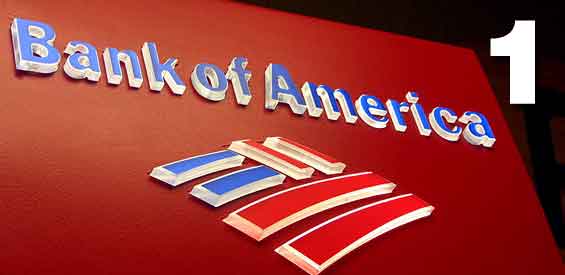 #1 Bank of America
#1 Bank of America
Bank of America ($30.6B) is the most valuable banking brand in the USA. Its brand value has increased by 18% and it has a brand rating of AAA-. Despite concerns of further mortgage-related write-downs, Bank of America is also currently the #1 most valuable banking brand in the world. In 2010, the company actively sought to repair its reputation — supporting new consumer protection legislation, modifying 285,000 loans, 76,000 in the fourth quarter alone, and engaging in more philanthropic activities — which was underpinned by strong results, the integration of Merrill Lynch and overall improvements in the consumer banking market.
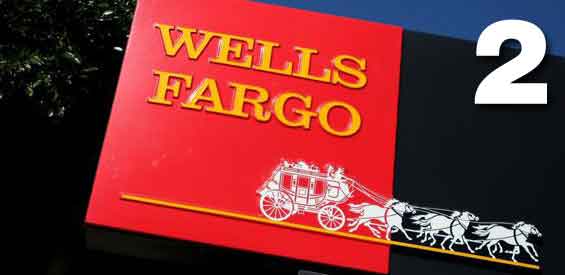 #2 Wells Fargo
#2 Wells Fargo
Wells Fargo ($28.9B) is the second most valuable banking brand in the USA with a brand rating of AA+. It had one of the highest net incomes in the country at $12.4B and this together with its conservative lending practices has helped it dodge many of the mortgage woes plaguing its rivals. Its brand value has increased by 32% this year, driven by its acquisition and subsequent rebrand of Wachovia. It held the top spot in home loans in 2010 and had the smallest exposure to Fannie Mae and Freddie Mac. While its rivals were brought down by the collapse in subprime mortgage, the majority of Wells Fargo’s didn’t because its sub-prime mortgages were of such high quality. It has more commercial banking branches (187) than its rivals which is a big plus, especially considering that the bank is targeting commercial lending as a key growth segment in the future.
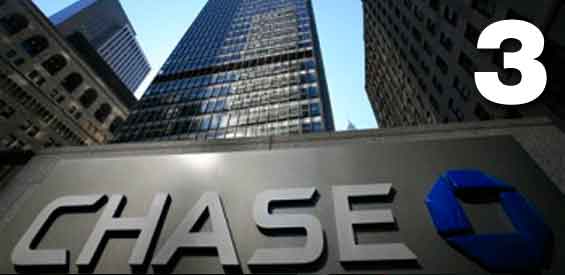 #3 Chase
#3 Chase
Chase has a brand value of $19.2B, an increase of 43% on the previous year and a Brand Rating of AA-. The huge increase in brand is mainly attributable of its acquisition of WaMu and its subsequent rebranding. This has given Chase its first major presence on the West Coast and resulted in the bank becoming the nation’s second-largest branch network, with locations reaching 42% of the US population. The acquisition also more than doubled the number of checking accounts to approximately 25 million.
Total net revenue for retail financial services during this period has amounted to US$25 billion. Although not as profitable, this is about US$5.9 billion higher than the investment banking division and is one of the contributors to Chase’s outperforming its sister bank in terms of brand value. This also reflects the general improvement in the retail banking sector over the past year.

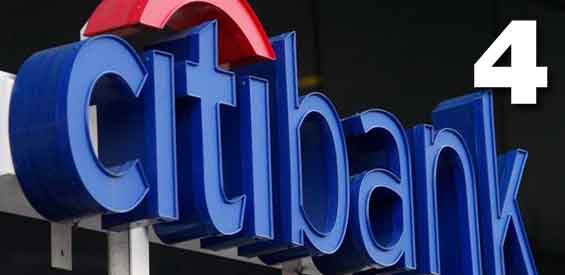 #4 Citi
#4 Citi
Citi was one of the worst affected financial institutions during the economic crisis and consequently its brand suffered. The bank has been uncertain about its long term direction while also being slow to admit errors. Recently it has been trying to rectify this by focusing on improving customer relations. Citi has also started repaying its TARP bailout funds. Even though it returned to profitability in December 2010, it has not convinced customers, shareholders or the markets that it has yet turned the corner. These factors have mean Citi’s value increased only slightly to $17.1B, based largely on its improved brand rating of AA.
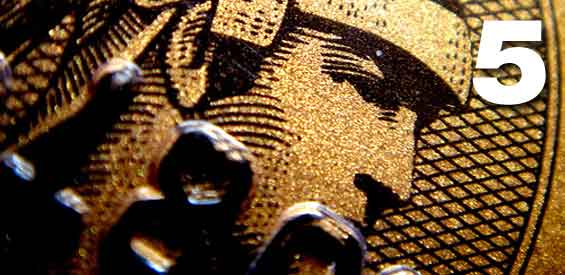 #5 American Express
#5 American Express
American Express’s brand value suffered drastically in 2009 but has almost recovered to its pre-crisis valuation, now at $15.5B. Its brand’s AA rating slid from 2008 when it was AAA. AmEx continues to be a strong brand because it has managed to weather the crisis much better than the rest of the industry. It has had one of the lowest default rates in the country as it caters to high income customers, reinforcing its image as a premium brand. It also has one of the most comprehensive rewards programs, earns the most revenue in annual fees compared to its competitors, and earns the highest proportion of income from card spending.
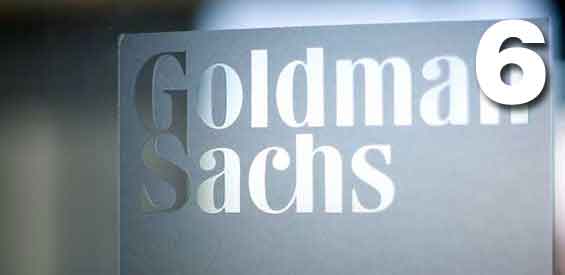 #6 Goldman Sachs
#6 Goldman Sachs
Goldman Sachs with a brand value of $13.4B is the sixth most valuable banking brand in the USA. It was the envy of Wall Street as the credit crisis struck but has since been engulfed by many a controversies — everything from CDO’s to Greece’s currency swap deal. This resulted in Goldman Sachs losing about 3% in brand value and a lower brand rating of AAA-. It has recently tried to repair its image by implementing the recommendations of its “Business Standards Committee,” but the real question is whether Goldman Sachs efforts are sincere or not.
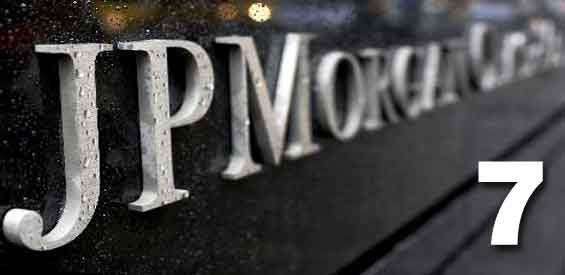 #7 JP Morgan
#7 JP Morgan
JP Morgan has been one exception among its peers, managing to increase its brand value to around $13.2B. Like other banks it has also suffered from negative public perception, trying to shake its image by focusing on both customers and employees. It announced record revenues in its global markets division of $22B, record investment banking fees of $7.2 billion.

The Financial Brand Forum Kicks Off May 20th
Explore the big ideas, new innovations and latest trends reshaping banking at The Financial Brand Forum. Will you be there? Don't get left behind.
Read More about The Financial Brand Forum Kicks Off May 20th

Unlocking Digital Acquisition: A Bank’s Journey to Become Digital-First
This webinar will offer a comprehensive roadmap for digital marketing success, from building foundational capabilities and structures and forging strategic partnerships, to assembling the right team.
Read More about Unlocking Digital Acquisition: A Bank’s Journey to Become Digital-First
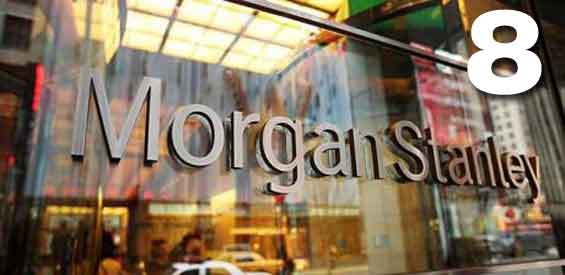 #8 Morgan Stanley
#8 Morgan Stanley
Morgan Stanley has had a rough ride. It has tried to make necessary changes in its strategy, but doubts remain over management’s ability to sell investments to small investors while also trying to deliver financial advice to major corporations. These doubts resulted in a decrease in brand value of 13%, down to $6.9B. It has, however, excellent cost management discipline. It’s on its way to building back its FICC division and has a strong Tier 1 capital ratio of 9.7%. This helped Morgan Stanley to improve its Brand Rating to AA-. They will have to work hard to maintain this rating.
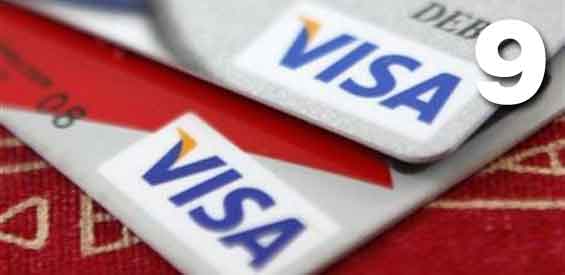 #9 Visa
#9 Visa
Visa is the largest branded credit- and debit card issuer. It has a brand value of $6.6B, an increase of almost 30% in brand value. It has a brand rating of AAA-, bolstered by two primary factors: (1) the growth in fees from emerging economies, and (2) the continuing transition to a cashless economy. Visa payments were up across the board around the world. However, new regulations mean there will be decreasing revenue from the USA market. But Visa is well poised to leverage its brand to expand further in the emerging markets. It continues to build international visibility, including huge worldwide sponsorships of the FIFA World Cup and the 2012 London Olympics.
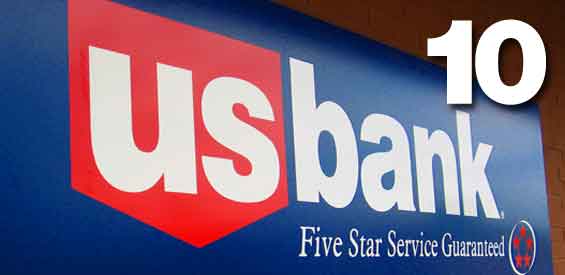 #10 US Bank
#10 US Bank
While the financial crisis has crippled many banks, varying in size from small regional banks to well known banks, US Bank has fared much better with its brand value increasing 43% to $5.4B and a brand rating of AA. It remained profitable throughout the crisis and recently announced that it was on track to achieve pre-crisis profitability levels. It also acquired two regional banks (Downey and PFF) increasing its reach and brand presence. It has a healthy Tier 1 capital ratio close to 11%, and has been ranked as one the safest banks in the US, just behind Wells Fargo. Coincidentally, Wells Fargo is poised to become one of US Bank’s main competitors, as they are both targeting commercial lending as a key growth segment.







